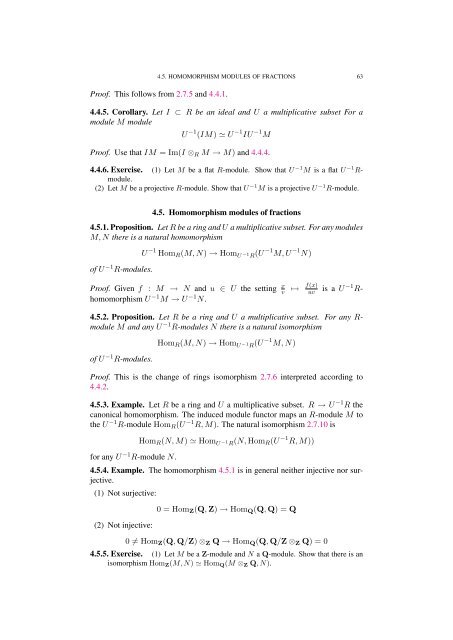Commutative algebra - Department of Mathematical Sciences - old ...
Commutative algebra - Department of Mathematical Sciences - old ...
Commutative algebra - Department of Mathematical Sciences - old ...
Create successful ePaper yourself
Turn your PDF publications into a flip-book with our unique Google optimized e-Paper software.
4.5. HOMOMORPHISM MODULES OF FRACTIONS 63<br />
Pro<strong>of</strong>. This follows from 2.7.5 and 4.4.1.<br />
4.4.5. Corollary. Let I ⊂ R be an ideal and U a multiplicative subset For a<br />
module M module<br />
U −1 (IM) U −1 IU −1 M<br />
Pro<strong>of</strong>. Use that IM = Im(I ⊗R M → M) and 4.4.4.<br />
4.4.6. Exercise. (1) Let M be a flat R-module. Show that U −1 M is a flat U −1 Rmodule.<br />
(2) Let M be a projective R-module. Show that U −1 M is a projective U −1 R-module.<br />
4.5. Homomorphism modules <strong>of</strong> fractions<br />
4.5.1. Proposition. Let R be a ring and U a multiplicative subset. For any modules<br />
M, N there is a natural homomorphism<br />
<strong>of</strong> U −1 R-modules.<br />
U −1 HomR(M, N) → Hom U −1 R(U −1 M, U −1 N)<br />
Pro<strong>of</strong>. Given f : M → N and u ∈ U the setting x<br />
homomorphism U −1 M → U −1 N.<br />
v ↦→ f(x)<br />
uv is a U −1R 4.5.2. Proposition. Let R be a ring and U a multiplicative subset. For any Rmodule<br />
M and any U −1 R-modules N there is a natural isomorphism<br />
<strong>of</strong> U −1 R-modules.<br />
HomR(M, N) → Hom U −1 R(U −1 M, N)<br />
Pro<strong>of</strong>. This is the change <strong>of</strong> rings isomorphism 2.7.6 interpreted according to<br />
4.4.2.<br />
4.5.3. Example. Let R be a ring and U a multiplicative subset. R → U −1 R the<br />
canonical homomorphism. The induced module functor maps an R-module M to<br />
the U −1 R-module HomR(U −1 R, M). The natural isomorphism 2.7.10 is<br />
for any U −1 R-module N.<br />
HomR(N, M) Hom U −1 R(N, HomR(U −1 R, M))<br />
4.5.4. Example. The homomorphism 4.5.1 is in general neither injective nor surjective.<br />
(1) Not surjective:<br />
(2) Not injective:<br />
0 = HomZ(Q, Z) → HomQ(Q, Q) = Q<br />
0 = HomZ(Q, Q/Z) ⊗Z Q → HomQ(Q, Q/Z ⊗Z Q) = 0<br />
4.5.5. Exercise. (1) Let M be a Z-module and N a Q-module. Show that there is an<br />
isomorphism HomZ(M, N) HomQ(M ⊗Z Q, N).
















